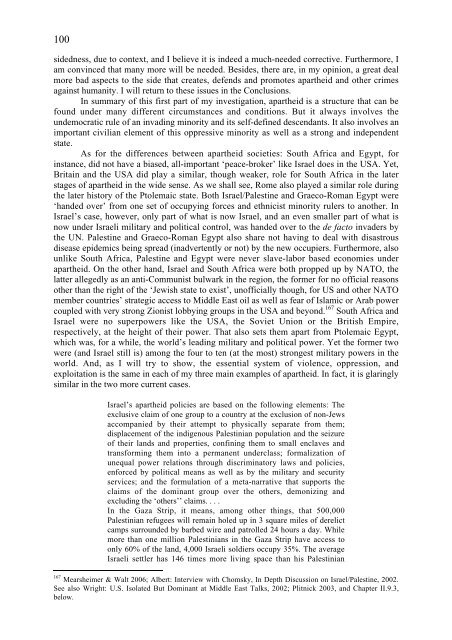Apartheid
Apartheid
Apartheid
You also want an ePaper? Increase the reach of your titles
YUMPU automatically turns print PDFs into web optimized ePapers that Google loves.
100<br />
sidedness, due to context, and I believe it is indeed a much-needed corrective. Furthermore, I<br />
am convinced that many more will be needed. Besides, there are, in my opinion, a great deal<br />
more bad aspects to the side that creates, defends and promotes apartheid and other crimes<br />
against humanity. I will return to these issues in the Conclusions.<br />
In summary of this first part of my investigation, apartheid is a structure that can be<br />
found under many different circumstances and conditions. But it always involves the<br />
undemocratic rule of an invading minority and its self-defined descendants. It also involves an<br />
important civilian element of this oppressive minority as well as a strong and independent<br />
state.<br />
As for the differences between apartheid societies: South Africa and Egypt, for<br />
instance, did not have a biased, all-important ‘peace-broker’ like Israel does in the USA. Yet,<br />
Britain and the USA did play a similar, though weaker, role for South Africa in the later<br />
stages of apartheid in the wide sense. As we shall see, Rome also played a similar role during<br />
the later history of the Ptolemaic state. Both Israel/Palestine and Graeco-Roman Egypt were<br />
‘handed over’ from one set of occupying forces and ethnicist minority rulers to another. In<br />
Israel’s case, however, only part of what is now Israel, and an even smaller part of what is<br />
now under Israeli military and political control, was handed over to the de facto invaders by<br />
the UN. Palestine and Graeco-Roman Egypt also share not having to deal with disastrous<br />
disease epidemics being spread (inadvertently or not) by the new occupiers. Furthermore, also<br />
unlike South Africa, Palestine and Egypt were never slave-labor based economies under<br />
apartheid. On the other hand, Israel and South Africa were both propped up by NATO, the<br />
latter allegedly as an anti-Communist bulwark in the region, the former for no official reasons<br />
other than the right of the ‘Jewish state to exist’, unofficially though, for US and other NATO<br />
member countries’ strategic access to Middle East oil as well as fear of Islamic or Arab power<br />
coupled with very strong Zionist lobbying groups in the USA and beyond. 167 South Africa and<br />
Israel were no superpowers like the USA, the Soviet Union or the British Empire,<br />
respectively, at the height of their power. That also sets them apart from Ptolemaic Egypt,<br />
which was, for a while, the world’s leading military and political power. Yet the former two<br />
were (and Israel still is) among the four to ten (at the most) strongest military powers in the<br />
world. And, as I will try to show, the essential system of violence, oppression, and<br />
exploitation is the same in each of my three main examples of apartheid. In fact, it is glaringly<br />
similar in the two more current cases.<br />
Israel’s apartheid policies are based on the following elements: The<br />
exclusive claim of one group to a country at the exclusion of non-Jews<br />
accompanied by their attempt to physically separate from them;<br />
displacement of the indigenous Palestinian population and the seizure<br />
of their lands and properties, confining them to small enclaves and<br />
transforming them into a permanent underclass; formalization of<br />
unequal power relations through discriminatory laws and policies,<br />
enforced by political means as well as by the military and security<br />
services; and the formulation of a meta-narrative that supports the<br />
claims of the dominant group over the others, demonizing and<br />
excluding the ‘others’’ claims. . . .<br />
In the Gaza Strip, it means, among other things, that 500,000<br />
Palestinian refugees will remain holed up in 3 square miles of derelict<br />
camps surrounded by barbed wire and patrolled 24 hours a day. While<br />
more than one million Palestinians in the Gaza Strip have access to<br />
only 60% of the land, 4,000 Israeli soldiers occupy 35%. The average<br />
Israeli settler has 146 times more living space than his Palestinian<br />
167 Mearsheimer & Walt 2006; Albert: Interview with Chomsky, In Depth Discussion on Israel/Palestine, 2002.<br />
See also Wright: U.S. Isolated But Dominant at Middle East Talks, 2002; Plitnick 2003, and Chapter II.9.3,<br />
below.

















